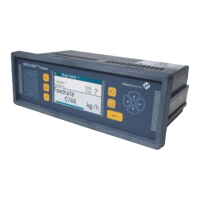Calibration functions
INTECONT® Tersus Belt weigher, Instruction Manual
Schenck Process Group
BV-H2464GB, 1234
- 29 -
Aborted !
Note:
The program routine is slightly different if there is a P13.03 Belt Sensor Active belt sensor:
The new reading is shown for impulses/belt circuit after every belt circuit.
If the sensor is not correctly identified, it gives the Error Sensor message and the adjustment program is
cancelled.
8.3
8.38.3
8.3
Tare TW
Tare TWTare TW
Tare TW
The taring program uses one or several whole-number belt circuits to record the zero point error of the belt-
weigher or weighfeeder. This value is used to correct the ongoing measuring results in normal operation.
We should distinguish taring from zeroing.
Taring:
Recording of the base tares (i.e., the weight of such things as the mechanism or
belt conveyor) when starting up, servicing and doing maintenance
Zeroing: Recording the operational zero deviation e,g, from soiling
The maximum correction stroke of the zeroing program is limited while that of the tare program is not.
After taring, the zeroing program bases the permissible correction deviation on the new reference
value.
Conditions:
1. Under no circumstances may there be any material on the belt. The prefeeder can be controlled with
'Feeder ON/OFF' function
2. The mechanical equipment within the scales area must be cleaned. You may leave deposits that will
develop again immediately in regular operation
3. Switch off batch mode
4. The belt conveyor must be running. Notice is given automatically
Sequence:
Calibration
TW: Tare
Call up the function distributor
Abort possible at any time
While the program is running, the display shows the remaining running period in % of the entire running
period and the constantly meaned tare in % of the rated belt load.
TW: Calibration active is shown in the header.

